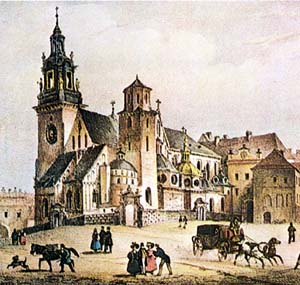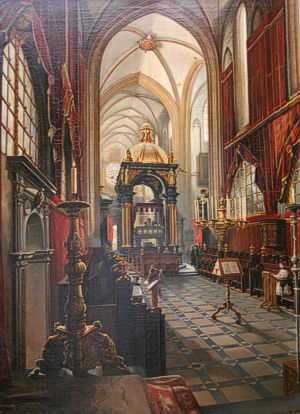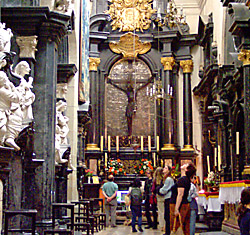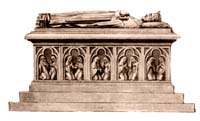 Wawel Cathedral in
Krakow
The Wawel Cathedral, Katedra Wawelska in Polish, was the
coronation site of Polish monarchs and remains Poland's most
important national sanctuary. Thanks to its 1000-year-old
history and numerous treasures the Krakow cathedral is
arguably the most interesting place in the whole country,
with the adjacent Wawel Royal Castle being the close second.
Its present 14th-century walls shelter a great variety of
top-class objects of art, from Gothic to Renaissance to
Baroque to Classicist to Modern. It is also
the burial ground of most Polish royalty as well as the
greatest national heroes, two poets, four saints and
countless Krakow bishops.
Treasures of the Wawel Cathedral
The center of the Wawel Cathedral's nave is occupied by the
1630 mausoleum of St. Stanislav, Poland's saint patron, the
11th-century Krakow bishop murdered by King Boleslav II
(1058–1079). The martyr’s silver coffin (circa 1670) is
adorned with 12 relief scenes from his life and posthumous
miracles. Marble tombs of four 17th-century Krakow prelates
accompany their saint predecessor's chapel-mausoleum.

The chancel of the
Wawel Cathedral in the mid-19th century with the mausoleum of
St. Stanislav in the background.
Near the main entrance to cathedral, between pillars on the
right side of the nave, there is an excellent 15th-century
late-Gothic sarcophagus of King Vladislav II Jagiello
(1386–1434) of red Hungarian marble. And on the left side it
is mirrored by the 1906 good imitation of a Gothic
sarcophagus by way of a symbolic tomb of King Vladislav III
Warnenczyk (1434–1444) whose body wasn't found on the
battlefield at Varna. At the end of the north aisle there is
the mid-l4th-century sandstone sarcophagus, the cathedral’s
oldest, of King Vladislav I the Short (1320–1333). His son,
King Casimir III Great (1333–1370), has his tomb on the
other side of the High Altar, across the nave, at the end of
the south aisle. The late-l4th-century red marble
sarcophagus ranks among Europe's best sculptures of the
period. In the middle of the south aisle one finds the 1902
sarcophagus of Queen-Saint Jadwiga (1384–1399) carved in
white Carrara marble with her grave insignia, wooden scepter
and orb, displayed near by.

The 14th-century
crucifix of Queen-Saint Jadwiga
in the
Wawel Cathedral
allegedly spoke to her.
Eighteen chapels full of art treasures surround the Wawel
Cathedral. Magnificent white “pearl of the Renaissance" vis-a-vis
the tomb of Queen Jadwiga, the
Sigismund Chapel, couples the exquisite Baroque of the
black marble Vasa Chapel. The Chapel of the Holy Cross
(first to the right on entrance) seems most interesting
owing to its 1470 Russian murals and the splendid 1492
marble sarcophagus of King Casimir IV Jagiello (1447–1492)
by Veit Stoss. The chapel also boasts two outstanding
late-Gothic triptychs by 15th-century Krakow painters, the
imposing 1789 late-Baroque tomb of Bishop Soltyk, and fine
stained-glass widows of the turn of the 20th century.
Other attractions of the Krakow cathedral
Crypts of
the Wawel Cathedral,
including the fine Romanesque underground chapel of St.
Leonard, have been turned into the nation's paramount
mausoleum with tombs of the royals and national heroes.
Two belfries of the Krakow Cathedral contain ten ancient
bells including giant Sigismund (Zygmunt)
bell of 1520 which visitors may see and even touch.
Note:
Box office in the building opposite the main gate of the
cathedral sells joint tickets for the cathedral, its royal
tombs, the Sigismund bell, and the Poets' Crypt.
Please remember to see the royal crypts at the end of you
visit to the cathedral as the exit leads outside.
The layout of the Wawel Cathedral

|
Wawel Hill
Wawel Hill in Krakow, the mecca of every Pole and a
must for foreign tourists, is a microcosm of Polish history and
culture.
Krakow's John Paul II Cathedral Museum
Wawel Royal Castle
Home to three dynasties of Poland's monarchs. Its
stately halls and exquisite chambers are filled with
priceless art, best period furniture and rare ancient
objects. The collection of the 16th-century monumental
Flemish tapestries is matchless.
Sigismund Chapel
The pearl of Renaissance architecture and art.
Every inch of its ideally proportioned stone walls and dome is
covered with fine sculptures.
Royal Tombs
Poland's medieval rulers are buried under their
sarcophagi in the Cathedral's nave. Visitors can also see crypts
with the tombs of the Renaissance and later monarchs.
Great Bell
Giant Zygmunt bell is a third heavier and 350 years
older than its famed London cousin, the Big Ben.
Black Christ's Crucifix
650-year-old, 13-foot-tall remarkable sculpture of the
Savior provided guidance to Queen-Saint Jadwiga in the 14th
century and has heard prayers of the faithful ever since.

Sandstone
sarcophagus of King Vladislav I the Short (1320–1333) dates to
the mid l4th century
In the footsteps of Pope John Paul
II
Krakow churches
Krakow numerous churches are architectural gems, art
hoards, and spiritual hubs
Roman Catholic Church
Sunday Masses
|
CATHEDRAL
(together with the Zygmunt bell and
Royal Tombs as well as the Cathedral
Museum) |
|
tickets normal 12 zlotys, reduced 7
zlotys. |
|
day |
from |
till |
|
Monday-Saturday |
9 a.m. |
5 p.m. |
|
Sundays and Holidays |
12:30 p.m. |
4 p.m. |
The Wawel Hill is accessible to visitors daily
since April through September from 6.00 a.m. to
8.00 p.m. and since October through March from
6.00 a.m. to 5.00 p.m. The Royal Castle's
arcaded courtyard is off limits half an hour
before the closing time.
The following are permanent
exhibitions of the Royal Castle on the
Wawel Hill:
Royal Chambers
(State Rooms) - historical interiors, tapestry
collection of Sigismund II Augustus, royal
portraits, Italian Renaissance furniture,
Italian and Dutch painting of the 14th to 17th
century.
Royal Private Apartments - rooms where
the Polish royalty lived, period furniture and
art.
Crown Treasury and Armory
- regalia, jewelry, precious weapons, armors and
caparisons; Polish and West European.
Oriental Art - Turkish tents
and banners, Turkish and Persian weapons and
carpets, Chinese and Japanese ceramics.
The Lost Wawel - archaeological
and architectural reserve of the early
11th-century church of St. St. Felix and
Adauctus' with surroundings; objects excavated
by archeologists on the Wawel Hill; ornate stove
tiles of the 16th and 17th century. Plus
multimedia presentation of the Wawel Hill's
history.
Dragon's Den - big
cave said to be the fiery monster's
hideout.
Admission terms and fees might be
subject to changes. For inquiries and booking
please contact the Tourist Service Office (BOT),
Wawel 5, 31-001 Kraków, Poland, tel.: (+48)
124225155 ext. 291, tel./fax: (+48) 124221697.
Email: zamek@wawel.krakow.pl
|
|
|
